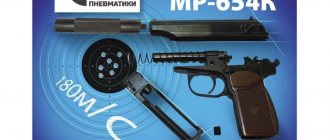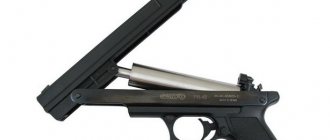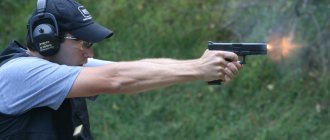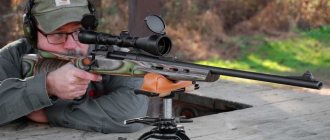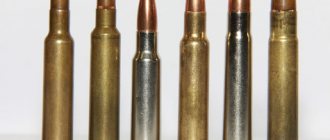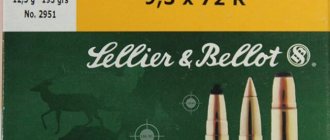Improving the performance of air guns is available for both traditional spring-piston options and PCP pneumatics. Improvement means increasing the accuracy, power, comfort of using a weapon, and extending its service life. Sometimes tuning turns out to be a necessary measure, which is necessary due to a breakdown of the original mechanism, but most often the owner of a pistol or rifle turns to a service center to simply improve the parameters of the air gun.
Thanks to our extensive experience, we can calculate the approximate cost of repairs remotely via the Internet. For this:
- take a photo of your air gun;
- Briefly describe what the problem is and how the breakdown occurred; indicate the model name (or photograph the weapon from several sides);
- send all this information to my email
Remember that the more detailed the information is, the more accurately and quickly the master will answer you. However, we can only tell you the exact price after inspecting the product live, before starting the repair. All prices and work are agreed upon before the start of repairs - so do not worry about possible additional expenses. We work strictly according to price.
The purpose of weapon modernization
There comes a time when the owner decides to modernize pneumatics in order to:
- improve performance characteristics (tactical and technical characteristics);
- change parts;
- work out the design.
In “direct hands” a pistol or rifle will become more powerful and the range of its capabilities will expand. Thus, the PPP or PCP turns from an ordinary “aircraft” for entertainment into a real hunting weapon.
Modernization allows you to increase the accuracy and range of shots by replacing a number of structural elements and installing an optical sight. Perhaps the trigger is too tight, the type of barrel is not suitable, etc.
Price list with prices for repairs:
- Diagnostics of technical condition from 150 rub.
- Installation of a swivel from 300 rub.
- Replacing the front sight on rifles from 300 rubles.
- Cleaning and lubrication of the gun from 200 rubles.
- Cleaning and lubricating the rifle from 400 rubles.
- Minor repairs of pistols from 200 rubles.
- Stock replacement from 400 rub.
- Sighting from 250 rub.
- Minor rifle repairs from 500 rubles.
- Replacement of a screw, gas spring from 1000 rubles.
- Power boost from 500 rub.
- Replacement of piston cuff from 800 rub.
- Replacement of a set of gaskets from 400 rubles.
- Replacement of gearbox, valve needle for PCP from 1200 rub.
- Repair, assembly of USM from 500 rub.
- Re-preservation of pneumatics from 800 rub.
- Installation of optical and collimator sights from 400 rubles.
- Replacement of gaskets in CO2 guns from 450 rubles.
- Adjustment and repair of the store from 1200 rubles.
- Repair of USM pneumatics and all types of pistols from RUB 1,500.
- Elimination of undershooting and sticking (pistol) from 1500 rub.
- Optical sight zeroing (according to LHP) 10m from 800 rub.
- Gun cleaning from RUB 1,150.
- Removing stuck bullets from RUB 900.
- Measurement of bullet departure speed from 150 rubles.
- Enlargement of the passage pupil RUB 1,600.
The site lists only a small part of the work that we perform daily. The exact cost depends on many factors: how complex the breakdown is, whether this part is in stock or needs to be ordered, on the complexity of the design and condition of the weapon, etc. Therefore, in order to determine the exact amount, it is best to come to the workshop immediately. And then you can decide whether you need to repair the product or whether it’s not worth it.
Workshop address and contacts
The first service center is located near the Tekstilshchiki metro station (SEAD): The workshop is located in Moscow, within walking distance from the Tekstilshchiki metro station (about 2-3 minutes on foot). Also, the nearest stations to us are Volzhskaya, Kuzminki, Tekstilshchiki and Pechatniki. There is free parking on site at the store. Exact address: st. Lyublinskaya, building 9, building 3. Before arriving, be sure to coordinate the time of your visit by calling 8 (499) 641-12-17 .
If you arrive without calling, there is a chance that you will not get into the workshop, and the likelihood of urgent repairs also decreases. Directions to the workshop: Within walking distance:
- from Tekstilshchiki metro station - 350 meters;
- TsMD Tekstilshchiki station - 520 meters.
You can also get to the workshop by bus:
- From Tekstilshchiki TsMD station: bus 234 - 1 stop;
- From Ugreshskaya metro station: buses M89, T38 - 3 stops;
- From Kuzminki metro station: bus 99 - 4 stops, bus 159 - 6 stops;
- From Volgogradsky Prospekt metro station: bus 99, trolleybus 27 - 4 stops;
- From Pechatniki metro station: buses 161, 193 - 4 stops.
The second service center for the repair of pneumatics is located near the Molodezhnaya metro station (JSC): Telephone: 8 (499) 149-17-57 Opening hours : Mon-Sun, from 10:00 to 20:00 Workshop address - Moscow, Yartsevskaya st. , 4 (Molodezhnaya metro station) Before arriving, be sure to agree on the time of your visit by phone. If you arrive without calling, there is a chance that you will not get into the workshop, and the likelihood of urgent repairs also decreases. Directions to the workshop: How to get to the workshop (5-10 minutes by public transport):
- From Molodezhnaya metro station: bus 794, minibus Auchan-7 - 1 stop, buses 73, 127, 464, 825, minibus 597 - 2 stops, bus 127B - 3 stops
- From the railway station Rabochy Poselok: bus 127B - 2 stops, bus 73 - 3 stops
- From the railway station Setun: buses 794, 794K - 3 stops
- From Kuntsevskaya metro station: bus 58 - 8 stops
Service center technicians:
1. Viktor Vladimirovich Orekhov Turner - mechanic. 7 years of experience in repairing air guns. Conducts diagnostics and carries out the entire range of work. 2. Sergey Nikolaevich Borodin Chief specialist. He is a retired military man and has been repairing weapons for more than 10 years. He is well versed in both pneumatics and airsoft, signal and cooled weapons. 3. Igor Petrovich Voznesensky Technician, electrician. A universal specialist, well versed in the operating features of airsoft weapon drives. 9 years of experience in repairing air rifles and pistols.
Ways to modernize air guns
“Airs” differ in their operating principle:
- Gas cylinders
- the energy source is liquefied carbon dioxide (CO2), located in a container - 12 or 88 g. - Pre-pumped (PCP)
- the method of pushing a bullet out of the barrel is similar to CO2 pneumatics, but instead of carbon dioxide, air is used, pumped into a high-pressure reservoir. - Spring-piston
- the spring sharply pushes out the piston, and the latter compresses the air inside the cylinder, creating high pressure.
The modernization method for each type of pneumatics is individual.
Power increase
Gas-cylinder pneumatics are an inexpensive short barrel up to 3 J. The bullet speed is 110-130 m/s, depending on the model. To improve performance, it is necessary to increase the power - the muzzle energy of the projectile.
For this:
- a rigid mainspring is installed;
- the standard trigger is replaced with a heavy one;
- are bored - the gas chamber, the exhaust valve hole, the obturator.
You can raise the NS (initial speed) by changing the standard barrel to a long one, or by using a removable extension (false muffler). If shooting is carried out with spherical bullets, and the part is rifled, it is worth installing an analogue with a smooth channel.
PCP devices - design features allow you to increase power in a couple of movements. But the upgrade and shooting of the air gun should be carried out in a workshop or other dedicated room.
Necessary:
- manipulate the needle;
- adjust the operation of the exhaust valve;
- inject gas instead of air into the HP (high pressure) tank (with caution);
- global work on weapons - replacing standard parts of the trigger mechanism (trigger mechanism), making changes to the design.
To pump more atmospheres into the PSP pneumatics, it is worth replacing the standard cylinder with a “reinforced” one.
PPP - these samples are strengthened by replacing a weakened (factory) spring with a stiff one - a couple of turns more. The main thing is that the spare parts fit the length of the cylinder and are made of a reliable alloy. The spring must match the pneumatic model.
You can increase the initial speed by replacing the standard short bolt connecting the rifle body with the breech with a long one. This will prevent air leakage through the hole. After unscrewing the standard fastener, it is drilled out 2 mm, then the recesses are turned out with a file. New bolts are screwed in slowly, and rubber seals are used to seal.
Increasing accuracy and accuracy of fire
Hitting the bull's eye is the dream of all shooters. The accuracy of air guns is controlled by zeroing, and it is very important to do it correctly. Accuracy is easier to deal with than accuracy (minimum spread of hits on the target), and this is important.
Many factors can change the trajectory of a projectile. The main ones are the type of ammunition (spherical, or lead - conical) and the bore - with or without rifling. For example, shooting lead bullets from a rifle will give better accuracy than spherical bullets from a smoothbore sample. But in the latter version the initial speed is higher. Conclusion - tuning should be carried out on all fronts, taking into account the performance characteristics of a specific type of “aircraft”.
Achieving maximum copy number
Leading arms companies produce pneumatic replicas of combat pistols. However, it is not always possible to achieve 100% similarity to the original. For example, some models are not equipped with a blowback function: the bolt rolls back, simulating shooting from a firearm.
With the help of features, owners are able to implement this system and improve the appearance of the device. As a result, it is difficult to distinguish an air pistol from a combat pistol.
Replacing the energy source
Gas cylinder and PCP devices can be switched to another energy source. To shoot a pistol, the owner spends money on a CO2 container. Over time, the desire disappears, as the user learns the truth that it is better to shoot with air - free, more effective than gas. The translation is carried out by making design changes, or by reworking the spent CO2 canister.
With PCP pneumatics everything is simpler: the tank is filled with air instead of CO2. The main thing is to pay attention to the type of new energy source, to prevent an overdose in order to avoid an explosion of the high pressure cylinder. It is safe to use neutral substances such as helium or argon. Fluid ones will not work - there will be problems with sealing.
Installation of body kit
The basic version of the “air” does not look so attractive, so owners install:
- Dovetail, Weaver or Picatinny mounting rails;
- Laser sights, collimator or optical sights;
- underbarrel flashlights;
- bipod;
- tactical grips.
Body kits also improve the quality of shooting from air guns.
Camouflage
Maybe it's time to do some external tuning of the pneumatics? For example, cover the surface with camouflage tape or paint it with gun paint. Camouflage is important for hunters - it helps to blend into the landscape so as not to scare away the prey.
It is not necessary to disassemble a rifle or pistol for painting, but it is advisable. The colors are selected taking into account the terrain and the owner’s preferences.
Are there any differences in the modification of pistols and rifles?
A spring-piston pistol is more difficult to modify than a rifle due to the small size of the pressure chamber. After replacing a standard spring with a reinforced one, problems often arise. You should not count on a significant increase in NA. Otherwise, the procedure for upgrading pneumatics is similar.
PCP and gas pistols (including rifles) work on the same principle, the only difference is the energy source. It is more difficult to modify pneumatics with pre-inflation.
Reducing the recoil of spring pneumatics and increasing shooting accuracy.
Spring-piston pneumatics are very simple in design, but for accurate shooting it is necessary to minimize recoil and vibration after the shot. Here I will try to tell you how to do this.
Let me remind you that the barrels of PPP rifles allow you to have an accuracy that is not inferior to PSR rifles, but recoil hinders its implementation.
First, let's look at the design of spring-piston pneumatics.
There is nothing complicated about it, I would even say that it is somewhat primitive. All spring piston rifles have this design, the only differences are in the charging method.
Let's analyze the moment of the shot into several important stages of the shot.
1. From piston failure to hitting the bottom of the compressor.
2. The impact of the piston on the bottom of the compressor, the bullet breaking off.
3. From the bullet breaking until it leaves the barrel.
First stage . The impulse of the piston breaking off from the trigger mechanism is negligible, so we will not take it into account. The piston has kinetic energy, depending on its speed and mass, the speed depends on the smoothness of the walls of the compressor, on the strength and type of spring, the increase in speed is prevented by the pressure in the compressor, which increases as the piston moves. The bullet closes the barrel from the breech side, behind the bottom of the compressor, thus creating a sealed chamber in which an air cushion is formed that brakes the piston.
Thus, the stiffer the air cushion, the softer and weaker the piston impact will be!
Any loss of compression in the chamber between the bullet and the piston collar leads to a decrease in resistance to the piston stroke and increased recoil. In order to avoid this, you need to monitor the rubber seals and the condition of the piston cup.
Compressor-bypass-bullet system.
Overflow hole
You can significantly reduce recoil and increase the rigidity of the air cushion by reducing the diameter of the overflow. The bypass is the transition from the compressor to the barrel through the (bypass) hole. A gun manufacturer makes a trade-off between accuracy and power. If you want to hit more accurately, the bypass hole needs to be made narrower, this is done by inserts and tabs, but not less than 2mm, otherwise the bullet’s ejection speed will drop significantly.
Let me make a reservation right away: it is NOT necessary to bore the reset to increase power, the recoil will increase very much and it will become generally problematic to hit anything.
Dead volume.
This is the bypass space between the bottom of the compressor and the bullet. The air in this parasitic space is not compressed, so it does not reduce recoil and does not push the bullet. The smallest dead volume for fractures, for other systems, depends on the design.
The only possible option to reduce it is to look for the “correct” cuffs for your rifle model. They are usually made handicraft, and yet the quality is not bad.
Second phase.
The piston hits the bottom of the compressor. The greater the mass of the piston with the spring and the higher its speed, the greater the kinetic energy. This cannot be eliminated, but the impact can be greatly reduced.
The first and easiest way is to increase the weight of the rifle . According to the law of conservation of energy, both systems will receive acceleration inversely proportional to mass. By increasing the weight of the rifle by 2 times, you will reduce the recoil by the same amount. This can be done simply by hammering plasticine into the butt, for example, or silicone sealant with shot (an idea from user Kolya).
Second way. Increasing system rigidity . To do this, it is necessary to make structural changes and create additional contact points with the stock. The higher the degree of fitting of the parts and the number of contact points, the less parasitic vibrations of the compressor system and the bed will be.
The third method is competent holding and aiming . By shooting the rifle with a constant grip, you will compensate for the barrel drift on average, by the distance by which the bullet is deflected while passing through the bore due to impact.
3. The bullet breaks and leaves the barrel.
The moment of breakdown.
There are a few points worth noting here. Firstly, this is the angle of the breech chamfer. It should be no less and no more, but equal to the angle of the bullet skirt , then it is less deformed and has an optimal stall force.
Usually the manufacturer makes the bevel angle convenient for loading, but from an efficiency point of view the breech angle should be ~55 degrees. Determined empirically. It is also decided by the selection of bullets.
Selection of bullet weight.
The bullet mass should be optimal, no more and no less. A light bullet is deformed, has problems with stabilization and is strongly deflected by the wind, and at a long distance it loses a lot of energy.
A bullet that is too heavy flies along a trajectory that is too steep and has low speed, so it stays in the barrel longer and gets more deflection. The weight of the bullet also affects its break force and, accordingly, recoil.
The optimal bullet weight depends on the energy of your rifle.
Next, the bullet is cut and flies down the barrel. At this time, the piston of the rifle had already received a recoil impulse, the main and most powerful one. The barrel oscillates according to the principle of a lever, so the longer it is and the less it weighs, the higher the amplitude of oscillations.
The muzzle and barrel trimming solve the problem . The muzzle is better made of metal due to the greater mass of the latter.
“makeshift” metal muzzle Gamo CFX
Factory made plastic muzzle.
You can cut a trunk up to 30cm (found out empirically). This will reduce the lever arm and, accordingly, the barrel vibrations. Before cutting the barrel, it is worth considering whether you can subsequently create a perfect muzzle chamfer.
Parasitic vibrations of the bed.
After hitting the compressor wall, the coiled spring experiences transverse vibrations. This can be heard as a ringing sound after a shot, a characteristic metallic sound. The resulting vibrations also reduce the accuracy of the shot; this can be combated in two proven ways - a telescopic guide and a gas spring.
Telescopic guide for MP-512.
They are usually made at home, but some models are equipped with them from the factory.
The spring is simply put on a telescopic guide, which prevents it from oscillating longitudinally.
Gas spring.
This system also reduces vibrations and is the most suitable.
The bullet leaves the barrel.
Air rifles are rifled weapons, so the bullet is stabilized by rotation. The moment the bullet leaves the barrel, it breaks off the rifling. The muzzle chamfer must be made perfectly smooth, the rifling must end at the same time. If this is not the case, the bullet breaks off the rifling, as if catching on the longer side, becomes deformed and vibrates along the longitudinal axis. The longer the bullet flies, the stronger these vibrations become, and over time they can completely destabilize the bullet.
It can be treated by modifying the muzzle chamfer; if ineffective, part of the barrel is cut off.
Here is a brief overview of some points affecting accuracy and impact; there is still a lot that is not considered here.
Thank you for your attention. December 17, 2013
How not to break the law when strengthening pneumatic weapons
A compressed air weapon may not pose a threat, but the ammunition fired from it is endowed with high penetrating power. When the bullet accelerates from the initial 100 to 120 m/s, it will become 1.5 times more dangerous.
According to the Federal Law “On Weapons”, devices using compressed air less than 7.5 J are allowed for free sale, without a license. If the owner decides to increase the muzzle energy (power), this is done gradually.
To calculate the J value, it is enough to know 2 variables:
- bullet mass;
- initial speed.
For example, shooting is carried out from a 4.5 mm PCP rifle. The weight of the bullets is 0.69 g. Initial speed – 120 m/s.
The “air” with such parameters fits into the permitted values - no more than 7.5 J. However, if you increase the HC by only 30 m/s, the muzzle energy will be 7.76 units, and this is already a criminal offense with the confiscation of the rifle.
Conclusion: upgrading pneumatics should only be carried out with a chronometer, but it is better to trust a specialist.
When you need expert help
It is better not to try to strengthen PCP pneumatics on your own: due to the design features, it is easy to deteriorate the performance. Parts may need to be replaced, and only experience will tell you which ones are suitable for a particular “air”. For example, changing a smooth barrel to a rifled one or shortening it can increase or decrease shooting performance.
It is not recommended to change the standard tank to an enlarged one yourself. The device may not be able to withstand increased loads.
Safe upgrade rules
When upgrading weapons, you must follow the safety rules:
- Do not place a spring that is too tight into the cylinder of a spring-piston pneumatic. At the moment of cocking, deformation of the metal elements may occur, which will provoke an unwanted shot.
- When shooting a reinforced rifle in an open area, it is important to make sure there are no people present. A fast-flying projectile is dangerous at long distances.
- When boring the cylinder walls to increase volume, a decrease in structural rigidity is unacceptable. The shooter risks injury as a result of depressurization.
What will high-quality tuning give?
A correctly performed upgrade will increase the power of the shot. This significantly expands the range of uses of the rifle. If previously you could only shoot at a piece of paper with a target, then after increasing the power you will be able to use pneumatics for hunting. Also, improving the power characteristics increases the range of the shot. The gun can be equipped with high-quality optics for hitting targets at long distances.
The following pneumatic tuning procedures are possible:
- replacing gas elements with better ones, selecting the optimal pressure in the system;
- installation of new cuffs with a long service life, so that the weapon does not have to be repaired frequently;
- modification of the piston and cylinder for more efficient firing;
- high-quality adjustment of the trigger mechanism to ensure softness and smoothness of its operation;
- chamfering the barrel, which improves the accuracy and accuracy of shots;
- polishing the working part of the barrel for smoother bullet movement and absence of deformation.
It is also possible to install optics in a service center and equip pneumatics with additional accessories. Typically, during the tuning process, a full service is performed, internal parts and working mechanisms are lubricated. This extends the life of the gun and reduces potential problems. The power increase is up to 20-30% after a set of works.
It is better to order tuning of an air rifle or pistol in a workshop where you will receive a guarantee on work and spare parts.
